Looking at thermal bento sets and lunch jars
I tend to be a traditionalist in the sense that I don't mind having room temperature food in my bentos. Most bentos are eaten that way. But when it's really cold outside, there's nothing more comforting than some hot food, or even a hot beverage. If you have access to a microwave, all you have to do is find a microwave-safe bento box. But if you don't, or you object to microwaves in general, a thermal lunch jar may be the thing for you.
There are two basic types of thermal lunch jars. Let's take a look at them.
The thermal stainless steel outer container type
The first time of thermal lunch jar consists of a stainless steel, insulated cylindrical container, into which one or more plastic containers fit in neatly. To use, you heat up the stainless steel outer container by pouring some boiling hot water into it for a few minutes, emptying out the hot water, then packing in the inner plastic containers.
Mr. Bento and its smaller sibling Ms. Bento are the best known of this type of thermal lunch set. This is a classic Mr. Bento set. There's the large stainless steel container with screw-on lid, a container to hold about 2.5 cups of cooked rice, a container with a screw-top lid with gasket to hold soup or other liquid, and two more containers to hold other foods. Everything fits inside the cylinder, so theoretically all the food should remain hot for some hours. (Not pictured are a non-insulated carrying bag and a pair of chopsticks in a plastic container.)
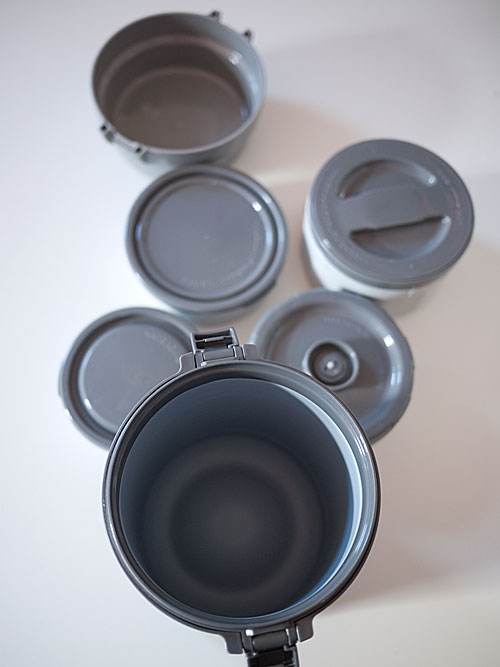
This container setup is ideally geared towards a classic Japanese meal construct, of rice, a small soup (miso or otherwise), plus sides. (See Anatomy of a Japanese meal for how a Japanese meal is put together.) When Zojirushi brought Mr. Bento over to the U.S. market, they kept the same construct. The only change made was to replace the chopsticks with a spork (though Ms. Bento still seems to come with chopsticks for some reason). So if you like multiple items in your bento/lunch, Mr. Bento is ideal for you. People commenting on Amazon seem to agree - it's been selling well there for years now.
The advantage of the Mr. Bento is that you can keep your entire lunch hot for hours if you wanted to. The disadvantages are that the container set itself is quite heavy (Mr. Bento with the carrying bag and chopsticks weighs about 1.2 kg or more than 2 pounds) and bulky. Plus, if you want to carry some food that's not hot, like fruit for example, you will need to carry yet another container separate from the unit. A not so small consideration is that thermal lunch sets of this type are not cheap, ranging from around $40 to $60.
A variation on the stainless steel thermal container with inner containers concept is this type of set is shown below. I got this set in Japan, but several international bento sellers, including Bento&co and J-List, sell similar sets. The set consists of a smaller stainless steel thermal container, into which fit the rice container and a small miso soup container. Then there are two more containers which are meant to be carried outside of the stainless steel cylinder.
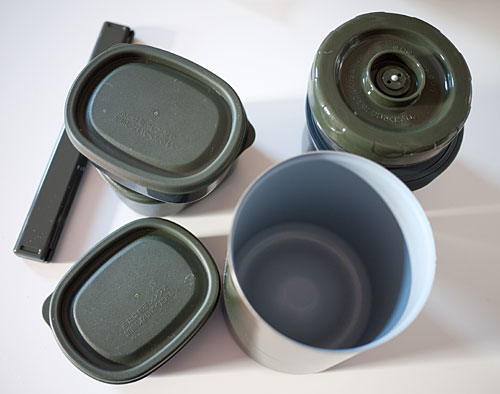
The rice container and the soup container. The soup container has a screwtop lid with gasket.

Everything fits neatly into this reasonably stylish insulated carrying case. These insulated carrying cases come in all shapes and sizes. Some even look like designer handbags.
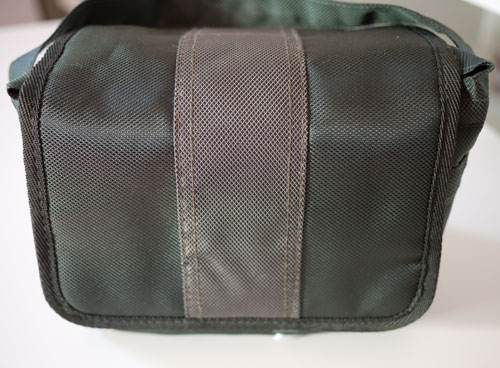
This unit is 30% lighter than the Mr. Bento set. Usually you only want your soup, and maybe your rice, to be really hot, and the other food can be just warm or even cool. If that fits your lunch patterns, this kind of partially-hot thermal set may be for you. (Keep in mind that the insulated carrying case will keep the outer containers reasonably warm, though not as well or as long as food inside the thermal cylinder.)
How to get the most out of the Mr. Bento type of thermal lunch set
To make sure that the food remains actually hot inside the thermal cylinder, make sure not to skip the heating up the cylinder with boiling water part. Also, the food you put in should be as hot as you want it to be and maybe more when you pack it inside. The container will not make cooled food hotter!
You can use the thermal cylinder without using all the inner containers. In my book I have a mini-muffin and soup bento, where I experimented with packing heated muffins in the heated container with soup in the soup container. The muffins were quite warm when I took them out, though they did get a bit moist. Try something like packing chili in the rice container, and a piece of warm cornbread in the space above it.
You can also use the thermal qualities of the steel cylinder to keep food cool. Try packing an ice pack inside the cylinder and freezing the whole cylinder overnight. In the morning, put a container of whatever you want kept really cold right on top of that frozen ice pack. I've tried this with ice cream, and it works - it was still pretty hard after about 3 hours!
The one unit type of thermal lunch container
The second type of thermal lunch container is a lot simpler. They are basically good old thermos bottles that are squat and wide mouthed, shaped for eating out of rather than sipping from. A good example is this Stainless Steel Food Container by Thermos. It comes in 10 ounce and 16 ounce sizes; the one pictured here is the 10 ounce, which is about 300 ml (1 1/4 cups). It's really simple, consisting of the body and a screw-on top with gasket.
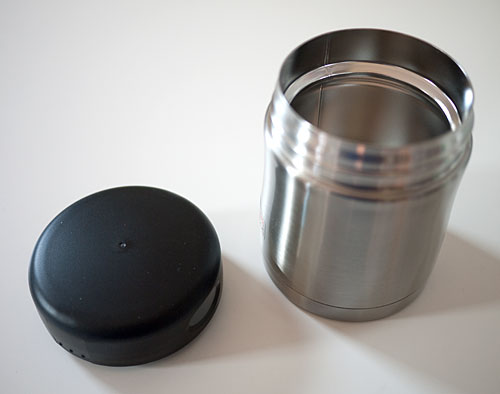
This is my current favorite thermal lunch jar, a Thermos Stainless King which holds 16 ounces (almost 500ml or 2 US cups). It has an inner screwtop lid with gasket and an outer lid that doubles as a cup.
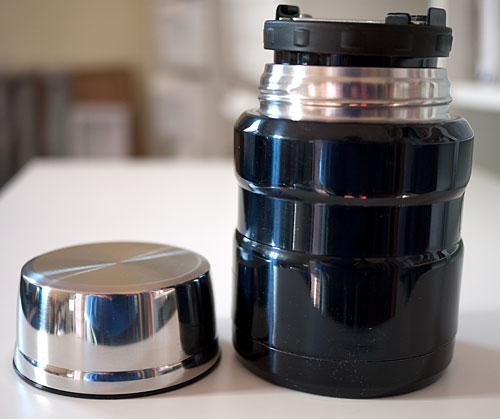
There's also a well designed folding spoon that clips into the top of the inner lid.
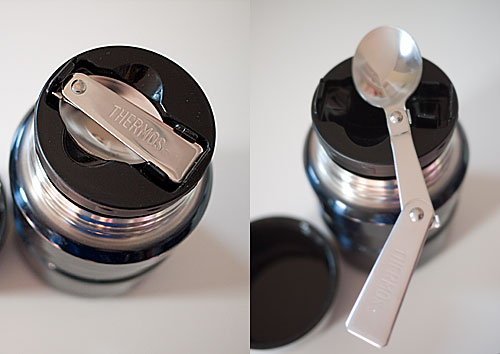
If all you want to do is to bring one hot item, say soup or stew, these one-piece lunch jars are ideal. If you already own some bento boxes, you can use a lunch jar to supplement them on cold days. Or you could just carry one on itself filled with soup, with a piece of bread in a plastic bag. They are also cheaper than the multi-part thermal lunch sets (since they are simpler), ranging in price from around $15 to $25, depending on the size, features and so on. (Keep an eye out for thermal jars sold as baby food containers if you're looking for a small container.)
In fact, if you're just starting out with bentos, or have been gazing at these pages and various bento blogs wondering if bentos are for you, a lunch jar just might be the ideal starter container for your bento journeys. Heating up some leftover soup and packing it into one of these takes almost no effort. And if you decide that bentos are not for you, you can still use a lunch jar for holding some hot chocolate or something.
Tips for getting the most out of a one-piece lunch jar
These lunch jars also benefit from a pre-heating before you fill them up. Just fill with boiling hot water, leave for a few minutes, empty an fill up with the piping hot food of your choice. The lunch jars can also be used to keep the contents cold.
I find it a bit harder to wash these compared to the inner containers that come with the steel-cylinder type. Try to wash them out as soon as possible. Handwash the gasketed inner screwtop lid to keep the seal tight - the other things are top rack dishwasher safe.
Not all food is good kept warm
There is one issue to keep in mind with all thermal lunch containers. Yes, these containers can keep your food really nice and hot for hours. However, keep in mind that that means the food continues to cook in that heat. So for maximum flavor and tastiness, stick to food that benefits from slow, gentle cooking. Soups, stews, curries and chilis work great. Steamed rice and other grains hold up well too. But other foods may suffer. Pre-cooked chicken may get dried out, and steamed vegetables may end up looking like the steamed vegetables you encounter on a sad buffet table. Hot pasta may sound like a great idea, but not if it turns out soggy and gooey. If you like a mix of foods, the partial-thermal type of set or just having a lunch jar plus regular, non-insulated containers may work better.
If you enjoyed this article, please consider supporting this site by becoming my patron via Patreon.
